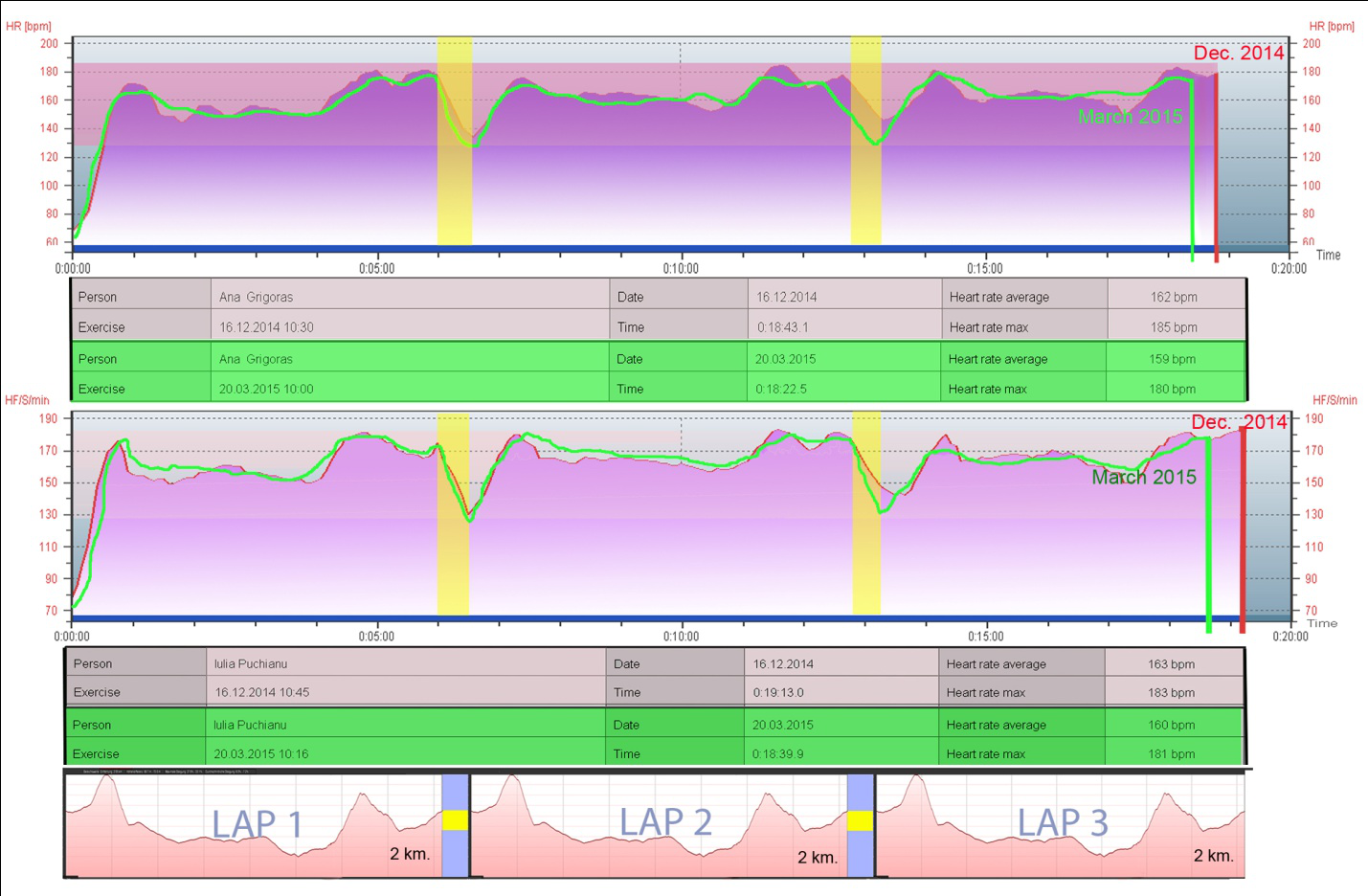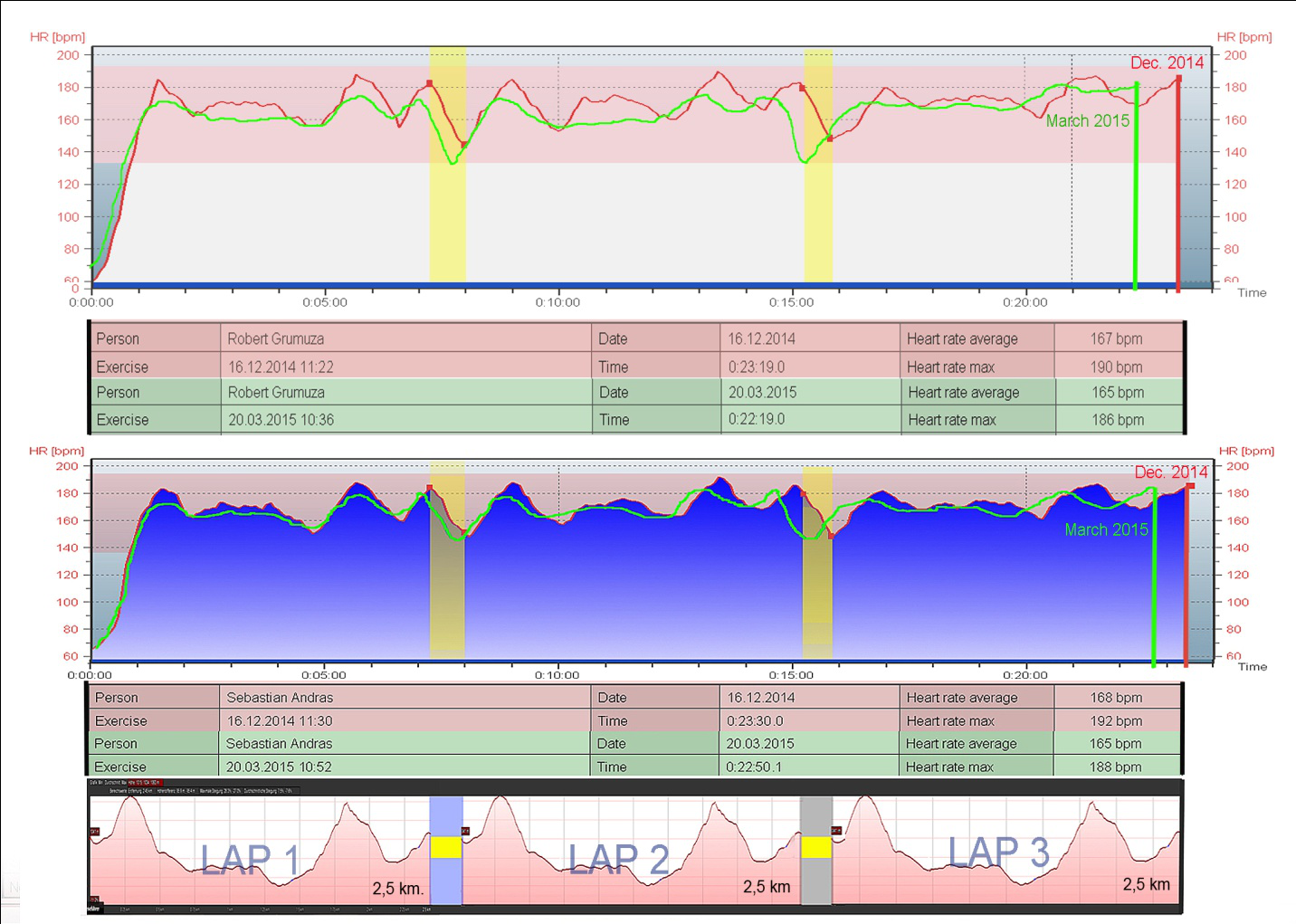Abstract
Nowadays, there is an increased, even urgent need for scientific education and training by increasing the theoretical and methodological preparation of all professionals in the cross-country skiing and biathlon field, all the more that we are approaching a new Olympic confrontation. Eliminating the obsolete conceptual means and introducing new ones meet the demands of current cross-country skiing and biathlon competitions. The main goals of this research are the following: to investigate coaches of all the teams participating in World Cup competitions with regard to the free style in cross-country skiing - biathlon and the use of technical procedures in training and competition during the year; to validate the landmarks (coordinates) for the energy consumption and time required to cover the route using the most effective methods for the free technique. One of the ways of access to high performance competitions at the international level for an athlete is also represented by the concern of crosscountry skiing and biathlon skiers to find the technical procedure able to expose them to less stress and to ensure the levelling of their heart rate values.
Keywords: Training, monitoring, performance
Introduction
In the last years, the world biathlon competitions have experienced a substantial increase in the
quality of athletic performances. Performance values have recorded significant increases from one year
to another. Such remarkable performance values have been achieved due to the contribution of the
following: improved quality of the equipment (skis, ski sticks, boots, ski wax, rifles, bullets etc.),
permanent improvement of the training means and methods, and the emergence of monitoring means in
this athletic discipline (Pelin, Gaspar, & Lungociu, 2007a: 7-8).
Nowadays, there is an increased, even urgent need for scientific education and training by
increasing the theoretical and methodological preparation of all professionals in the cross-country
skiing and biathlon field, all the more that we are approaching a new Olympic competition.
The removal of conceptually obsolete means and the introduction of other new means comply with
the requirements of the current competitions of cross-country skiing – biathlon (Pelin, Lungociu, &
Pelin, 2007b: 140).
The main purposes of the study are:
a) To investigate coaches of all the teams participating in the World Cup contests with regard to the
free style in cross-country skiing and the use of technical procedures in training sessions and in
competitions (cross-sectional study);
b) To validate some coordinates for the energy consumption and track running time, using the most
effective free-style technical procedures in cross-country skiing.
Materials and methods
Assumptions
The use of technical procedures for running on skis according to their effectiveness (energy
consumption and track running time) leads to the improvement of ski running performance values.
A more detailed investigation of the technical procedures and a good tactical strategy used during
the technical procedures can ensure the levelling of heart rate (HR) values during the entire route.
Tasks
To obtain the results of the questionnaire prepared and applied to the best coaches of cross-country
skiing – biathlon-type in the world;
To determine the effectiveness of technical procedures for ski running, the manner in which such
means request the athlete skills and the weight of use of such means in the training of skiers;
To make the telemetric HR records and to record the running time values for each technical
procedure, by carrying out tests at the beginning and the end of the competitive season;
To obtain some concrete data from the training sessions and contests by means of telemetric
records, in order to be able to confirm the assumptions.
Research methods
The following methods were used in this research: bibliographical study, direct and indirect
observation (Epuran, 2005: 207), questionnaire method and graphical method using
710 i.
Subjects and location
This research included the participation of 4 athletes aged between 12 and 14 years, from
“Brasovia” Sports School. These athletes followed a training program also used for several years by
top athletes of the country, who won medals at international competitions. The research was
undertaken as follows:
•In the month of December 2014, the initial testing was held on the Predeal track; •In the period from December 2014 to March 2015, the training program was applied to the athletes; •In the month of March 2015, the final test took place on the Predeal track.
Results
Presentation, assessment and interpretation of data obtained from the questionnaire given to the best
coaches of biathlon in the world:
Item 1: Which of the two technical procedures do you consider more efficient?
Response: V1 = 9%; V2 = 91%
Item 2: Which of the two technical procedures implies more the technical abilities of the skiers?
Response: V1 = 10%; V2 = 90%
Item 3: Which is the percentage use of the two technical procedures in the training of skiers?
a = 3%, b = 83%, c = 25%, d = 100%
a) VI = 50%; V2= 50% b) VI = 75%; V2= 25% c) VI = 25%; V2= 75% d) According to the land profile
V1 = Two skating paces with simultaneous push
V2 = One skating pace with simultaneous push
The use of pulse testers in the cross-country skiing and biathlon has become a need since long time
ago, at a global level. We can acknowledge that we had the occasion to use, for the first time in
Romania, the pulse testers for the Olympic biathlon teams. Currently, the HR records are carried out at
each training session and during each competition. After we have analysed the opinions of the biathlon
coaches from our country and from abroad, we could determine the most effective ski running
procedures. Then, the coach of the athletes from C.S.S. Brasovia, who trained also the Romanian
national biathlon team for a long time, monitored the athletes’ running between the two tests, requiring
them to use the most effective procedure.
Monitoring, by successive tests, the HR dynamics in the different ski running procedures used by
the athletes, we could determine with certainty that moving by means of a skating pace and
simultaneous push leads to one of the lowest heart rate values.
Pursuant testing carried out in December, the following aspects are found:
•with regard to the HR evolution in the tests carried out, it is certain that HR values are lower for skating pace with simultaneous push;
•the energetic cost for this procedure is low, showing the effectiveness of the use of such procedure, and the running time value is lower, too, in this procedure;
•in the case of the second technical procedure used, consisting of two skating paces with simultaneous push by the ski sticks, the HR values are higher, but the running time value is better than
that in the first technical procedure. We note that, on some portions of the track (i.e. in climbing), the
use of this technical procedure results in “time gain”.
We could determine that athletes were not yet aware of the appropriate use of the technical
procedures according to the characteristics of the track, having already shaped some automatism
concerning the use of technical procedures.
Therefore, the need to intensively practice, during the training sessions, the use of technical
procedure according to the track characteristics appeared.


Analysing the results of the test carried out in March (Fig. 1. - girls and Fig. 2. - boys), we can
observe that the procedure consisting of one skating pace with simultaneous push by the ski sticks
represents the most effective procedure in terms of HR values, the average of such values being the
lowest possible, as well as in terms of track running time values, which are the lowest compared to
those obtained with other technical procedures, for all four athletes.
We can confirm the starting assumption that the technical running procedures must be used
according to their effectiveness in terms of energy cost and running speed. Even if the advancement
speed (in climbing) is slightly lower than the speed reached in the other moving forms, the ratio
between the speed reached and the energy consumption provided by the skating pace with
simultaneous push brings substantial benefits in terms of competing economy. The athlete can manage
better his/her resources, as highlighted by both the decrease in the number of failures on the polygon
and the improvement of the final running time values.
At the last recording (Fig. 1 and Fig. 2), all the four athletes roughly succeeded to obtain constant
and closer HR values. It is obvious that they managed to use the technical procedures according to their
effectiveness, and thus they present lower oscillations in the HR values.
Conclusions
Initially, based on the experimental ascertaining study data, it was determined that the research
subjects did not have an automatism formed with regard to the use of technical procedures according to
their effectiveness.
As to the HR and running time values recorded for the technical procedure considered the most
effective by us, all the four athletes could aim performance values in the ski running contests higher
than those obtained until now.
The results of the training experiment lead to the opinion that the research assumption was correctly
expressed and confirmed. The requirement for achieving higher progress would imply a longer
duration of the experiment.
The system of technical means and methods used resulted in the mitigation of the oscillations in the
HR values during the running period for the entire track. The last recording carried out shows the clear
trend of HR value levelling throughout the contest duration.
The concern for using technical procedures according to the land characteristics, track quality, snow
condition etc. does not simply represent a target unless it is justified by an improvement of the running
speed on the track. Therefore, the need of obtaining an optimal ratio between the technical procedure
used and the track profile is a real issue. Interventions to mitigate this ratio shall be undertaken
depending on the inclination of the skier for a certain technical procedure able to expose him to less
stress, but showing levelling of the heart rate values during the entire contest duration.
It can be alleged, based also on our research, that one of the ways of access to high performance
competitions at the international level for an athlete is also represented by the concern of cross-country
skiing and biathlon skiers to find the technical procedure able to expose them to less stress and to
ensure the levelling of their heart rate values.
References
Epuran, M. (2005). Metodologia cercetării activităţilor corporale – Exerciţii fizice – Sport – Fitness (ediţia a 2-a). București: FEST.
Pelin, F., Gaspar P., & Lungociu I. (2007). Schi fond. Antrenament, planificare, modelare. București:
Cavallioti.
Pelin, F., Lungociu, I., & Pelin, Gh. (2007). Antrenamentul de tir pentru biatlon. București: Printech.
Pulse-tester Polar 710 i. Retrieved from http://www.polar.com
Polar USB IR Interface. Retrieved from http://www.polar.com/de/support/polar_usb_interface_installationspaket
Copyright information

This work is licensed under a Creative Commons Attribution-NonCommercial-NoDerivatives 4.0 International License.
About this article
Publication Date
10 June 2016
Article Doi
eBook ISBN
978-1-80296-010-5
Publisher
Future Academy
Volume
11
Print ISBN (optional)
-
Edition Number
1st Edition
Pages
1-509
Subjects
Sports, sport science, physical education
Cite this article as:
Florin, P., Orlando, C., & Gheorghe, P. (2016). Study on Using the Processes of Freestyle Skiing and Biathlon by Their Efficiency. In V. Grigore, M. Stanescu, & M. Paunescu (Eds.), Physical Education, Sport and Kinetotherapy - ICPESK 2015, vol 11. European Proceedings of Social and Behavioural Sciences (pp. 385-390). Future Academy. https://doi.org/10.15405/epsbs.2016.06.53

